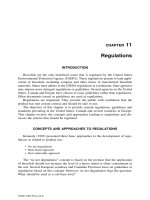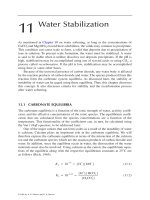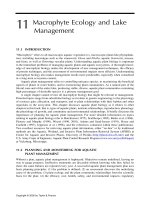Ecomomics evelopment 10th y p todaro and smith chapter 11
Bạn đang xem bản rút gọn của tài liệu. Xem và tải ngay bản đầy đủ của tài liệu tại đây (262.58 KB, 26 trang )
Chapter 11
Development
Policymaking
and the Roles of
Market, State,
and Civil Society
Copyright © 2009 Pearson Addison-Wesley. All rights reserved.
System of Economic Management
Mixed economy
• Private sector: profit maximizing business firms
• Public sector: employment maximizing
government agencies
Economic systems
• Capitalism: large private sector, but small public
sector
• Socialism: large public sector, but small private
Copyright
sector © 2009 Pearson AddisonWesley. All rights reserved.
11-2
Economic Role of the State
•
Protect private property and legal rights
•
Produce public goods
•
Improve market competition
•
Improve income distribution
•
Preserve the human environment
•
Manage the economy
Copyright © 2009 Pearson AddisonWesley. All rights reserved.
11-3
Development Planning
Economic plan: managing economic activity
•
Specific set of quantitative targets
•
Given time horizon (three or five years)
•
Stated strategies for achieving the targets
•
Comprehensive (the entire economy) or partial (a specific sector or industry) coverage
Copyright © 2009 Pearson AddisonWesley. All rights reserved.
11-4
Component of Development Plan
•
Government uses domestic saving and foreign exchange to construct economic infrastructure
•
Government implements economic policy (taxation, industrialization, foreign exchange control, trade restriction)
Copyright © 2009 Pearson AddisonWesley. All rights reserved.
11-5
Rationale for Planning
Reduce market failure:
•
Income distribution
•
Monopoly power
•
Externalities of production and consumption
•
Insufficient information
Copyright © 2009 Pearson AddisonWesley. All rights reserved.
11-6
Rationale for Planning
•
Resource mobilization and allocation
•
Psychological effect on achieving development goals (e.g., reducing poverty)
•
Foreign aid: a requirement to obtain loans and grants
Copyright © 2009 Pearson AddisonWesley. All rights reserved.
11-7
Planning Characteristics
•
Governmental goals and objectives
•
Strategies for achieving goals and objectives
•
Government agency for planning implementation
•
Planning coverage: comprehensive or partial
•
Planning horizon: medium or long-term
•
Planning methodology (macroeconomic model)
Copyright © 2009 Pearson AddisonWesley. All rights reserved.
11-8
Planning Methodology
Aggregate growth model (Harrod-Domar)
•
Investment demand = National saving
•
Foreign aid and direct foreign investment to fill-in the saving gap
Copyright © 2009 Pearson AddisonWesley. All rights reserved.
11-9
Planning Methodology
Input-Output model
•
Outputs of industries serve as inputs of other industries
•
Optimal input mix to produce maximum output to satisfy the final demand
Copyright © 2009 Pearson AddisonWesley. All rights reserved.
11-10
Project Appraisal
•
Weigh the costs of plans/projects against their benefits over the planning horizon
•
Discount the costs and benefits and compare their present values
•
Find an appropriate “discount factor” above the internal rate of return”
•
“Net” at which present value equal to zero
Copyright © 2009 Pearson AddisonWesley. All rights reserved.
11-11
Project Appraisal
Net present value, or NPV is given by
Bt − Ct
NPV = ∑
t
t (1 + r )
Where
Bt is the expected benefit at time t
Ct is the expected cost at time t
r is the government’s social rate of
Copyright © 2009 Pearson
Addisondiscount
Wesley. All rights reserved.
11-12
True vs. Actual Market Value
•
True market value in the demand-supply price or scarcity value = shadow price reflecting social costs and
benefits
•
Actual market value is the market exchanged price reflecting private costs and benefits or the controlled price
Copyright © 2009 Pearson AddisonWesley. All rights reserved.
11-13
Reasons for Price Divergence
•
Inflation and currency control
•
Factor price distortions (prices, wages, interest rates, exchange rate)
•
Trade restrictions and import substitution
•
Saving deficiency
•
Social vs. private rate of return
Copyright © 2009 Pearson AddisonWesley. All rights reserved.
11-14
Planning Consequences
•
Factor price distortion, choice of technology and employment creation
•
Induced R-U migration
•
Demand for educational certification leading to employment problem
•
Economic structure
Copyright © 2009 Pearson AddisonWesley. All rights reserved.
11-15
Reasons for Failure of Planning
•
Deficiencies in plans and their implementations
•
External and internal disturbances
•
Insufficient and unreliable data
•
Institutional weaknesses
•
Lack of political will
•
Corruption of public servants
Copyright © 2009 Pearson AddisonWesley. All rights reserved.
11-16
The Planning Mystique
•
In the past, few doubted the importance and usefulness of national economic plans
•
Recently, however, disillusionment has set
•
But, a comprehensive development policy framework can play an important role in accelerating growth and reducing
poverty
Copyright © 2009 Pearson AddisonWesley. All rights reserved.
11-17
Resurgent of Market Orientation
•
Failure of planning
•
IMF and World Bank policy requirements for foreign aid and direct foreign investment
•
Joint ventures of domestic and foreign enterprises
Copyright © 2009 Pearson AddisonWesley. All rights reserved.
11-18
Requirements for Market Orientation
•
Trust
•
Law and order
•
Security of private property rights
•
Balancing between competition and cooperation
•
Division of responsibility and diffusion of power
•
Social safety net
Copyright © 2009 Pearson AddisonWesley. All rights reserved.
11-19
Requirements for Market Orientation
•
Social mobility
•
Individualism and materialism
•
Deferring gratification to create private saving
•
Rationality and efficiency
•
Honesty of government
•
Competition of business
•
Availability and freedom of information
Copyright © 2009 Pearson AddisonWesley. All rights reserved.
11-20
Need for Government
Intervention
•
Income redistribution through progressive taxation and transfer payments
•
Excess market imperfection on behalf of domestic and foreign business
•
Substantial negative externalities (pollution and decay)
•
Investment in social and human capital
•
Structural transformation
Copyright © 2009 Pearson AddisonWesley. All rights reserved.
11-21
Planning & Market
Reconciliation
•
Must achieve “effective” cooperation
•
Must reduce market imperfections
•
Must eliminate factor price distortions and price controls
•
Must reduce public ownership of economic enterprises
•
Must reduce corruption and red tape
Copyright © 2009 Pearson AddisonWesley. All rights reserved.
11-22
Non-Government Organizations
• Comparative advantages of NGOs in
Innovative design and implementation
Program flexibility
Specialized technical knowledge
Provision of targeted local public goods
Common-property resource management design and
implementation
– Trust and Credibility
– Representation and advocacy
–
–
–
–
–
Copyright © 2009 Pearson AddisonWesley. All rights reserved.
11-23
Corruption and Planning
• Corruption: Abuse of public trust for private gain
• Good governance enhances capability to function
• Effects of corruption fall disproportionately on the
poor
• Good governance is broader than simply an
absence of corruption
Copyright © 2009 Pearson AddisonWesley. All rights reserved.
11-24
Corruption as a Regressive Tax:
The Case of Ecuador
Copyright © 2009 Pearson AddisonWesley. All rights reserved.
11-25









